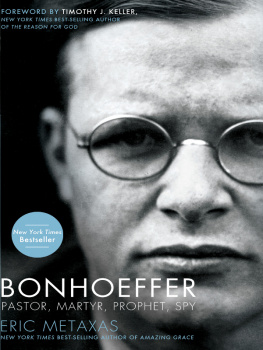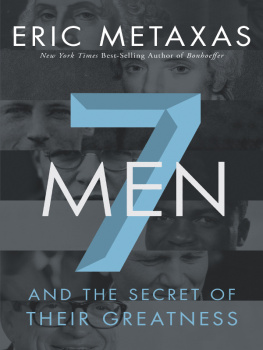More Praise for FORGED IN CRISIS
A remarkably insightful book, written in a style that is consistently engaging and absorbing, which reminds us that leaders are made not born and that the crucibles from which they emerge are, above all, tests of character. Koehn gives us one stunning example after another of individuals who endured deep loneliness while betting the ranch on a hard-to-predict outcome. We hold our breath along with them and exhale when, after sometimes agonizing losses, they finally succeedor fail gloriously. Standing back from these stirring accounts, we can't help but marvel at the moral compass that, in each of these people, always pointed true north. This book is a wonderexactly the leadership road map needed for these challenging times.
Les Wexner, chairman and CEO of L Brands
Nancy Koehn vividly shows the qualities shared by five of historys greatest leadersand how we can all tap into those same qualities to overcome challenges and confront crises in our own lives. Forged in Crisis is an inspirational, insightful, and indispensable guide to perseverance, wisdom, and resilience.
Arianna Huffington, founder of The Huffington Post and founder and CEO of Thrive Global
Emotionally grippingso much so that its easy to forget one is reading nonfiction. The scenes have the pull of a great novel, continually coaxing us to turn pages. Perhaps it is this propulsive power that accounts for how thoroughly we take in the books insights. Long after Forged in Crisis has been set down, we reflect on what it teaches us about managing crisis. The demonwhatever it isis never slain by a single bullet. Rather whats required is an iterative process: repeated attempts, different angles of attack. It is the willingness of the great leader to keep on trying past anyone elses point of exhaustion that often yields success.
Joseph Nye, former dean of Harvard Kennedy School and author of The Powers to Lead
An outstanding rebuttal of the myth that leaders somehow have different DNA than ordinary people. Koehns profiles of legendary figures reveal that, in fact, none of these people were leadership naturalsrather, their abilities were forged by the challenges they confronted. During trying times, they kept an unwavering resolve and put others needs before their own. Their example ought to inspire every aspiring leader to rise to the occasion.
William P. Lauder, executive chairman, the Este Lauder Companies
A powerful and timely treatise on leadership, Forged in Crisis presents five compelling portraits of individuals who made a lasting impact on the world in times of extraordinary challenge. Nancy Koehn is a seriously talented historian who has a gift for mining the past to elucidate the present. She writes with verve and vivid detail.
Graham Allison, former assistant secretary of state and author of Essence of Decision and Destined for War
Koehns well-written and incisive study helps to show us the way to a better nation. Wisely, she chooses to portray people from different races, genders, and eras, [carving] out a new and clearer definition of leadership in the world. In many ways, the book is like John F. Kennedys Profiles in Courage . This is a very perceptive look at leadership in the modern era that taps leadership qualities from the past.
Bruce Chadwick, author of Law and Disorder, James and Doll e y Madison , and The General and Mrs. Washington
Vividly re-creates the anguish and urgency felt by five trailblazing leaders in times of great adversity. With spirited prose that highlights crucial moments of testing and triumph, Nancy Koehn breathes life into the past as she shows what it takes to lead. In challenging times, this book is an essential read.
Zo Baird, CEO and president, the Markle Foundation
To Kelly Close, who has always understood that the impossible is made possible by resilience, courageous leadership, and an abiding faith that right makes might
INTRODUCTION
The Call of History
P icture in your mind three snapshots from the past. The first is from late 1915. Ernest Shackleton, an explorer from Great Britain, and his twenty-seven men are trapped on an iceberg off the coast of Antarctica. Their ship, the Endurance , has gone down through the ice, and he and his crew are marooned a thousand miles from civilization with three lifeboats, canned food, and no means of communicating with the outside world. Shackletons mission is somehowagainst all oddsto bring his entire team home safely. But he doesnt know how he will do this. At night, when he cant sleep, he slips outside his tent and paces the ice as he considers his next move. Sometimes, he doubts his ability to do what he knows he must.
The second snapshot is from the summer of 1862. Abraham Lincoln, the president of the United States, is also uncertain about how he will accomplish his purpose: to save the Union in the midst of a civil war. He, too, has trouble sleeping and often spends the hours after midnight walking up and down the second-floor hall of the White House. The conflict is going badly for government armies and is proving much bloodier than anyone could have imagined. The commander in chief knows that slavery is at the heart of the contest. But hes unsure exactly what to do about the almost 4 million black Americans held in bondage. Hes also living with intense personal grief following the death of his son Willie four months earlier. In certain moments, Lincoln staggers under the weight he carries.
The third image is from the winter of 1961. Its late at night, and Rachel Carson, a scientist and bestselling author, is alone in her study, trying to finish a manuscript titled Silent Spring, about the dangers of widespread pesticide use. Her subject is controversial, and she knows that large chemical companies, the US Department of Agriculture, and other powerful institutions are poised to make war on her and the book as soon as its published. Despite the threats, Carson believes deeply in the works integrity and larger message: that humankind has an obligation to protect the earth and that this obligation involves a sweeping call to citizen awareness and action. She writes as carefully as she can, her work given urgency not only by the importance of her subject, but also by her medical situation. For more than a year, she has been battling aggressive, metastasizing cancer. Carson realizes she may not have much time left, and in certain moments, she doubts she can actually complete her book and say what must be said. When her anxiety rises, the author walks around the room, staring out into the darkness.
Each of these three snapshots shows us a leader poised to take a critical step forward. Shackleton, Lincoln, and Carson found themselves in a position to make an enormous difference, and each rose to the challenge. Their stories, like those of the two other leaders here, Frederick Douglass and Dietrich Bonhoeffer, are as astounding as any from the great myths, adventure novels, and films that we remember and return to again and again. The difference is that these five stories are real; they actually happened . Theyre part of our past, and while each of these stories mattered a great deal in their respective eras, they also have much to offer our generation and those that come after.
The five leaders in this book are important to us today because we live in a moment when our collective faith in national figuresbe they from government, business, or religionis waning. When we think about the latest election or most recent financial scandal and take stock of the people we call leaders, we grow concerned that the men and women capable of tackling the problems and delivering on the promise of this age arent among their ranks.
Next page









